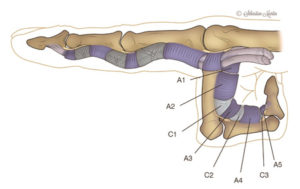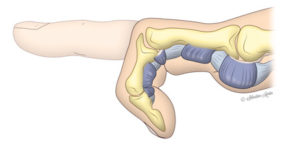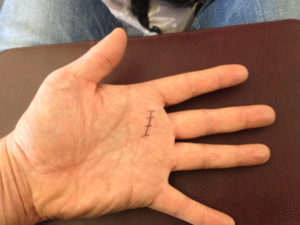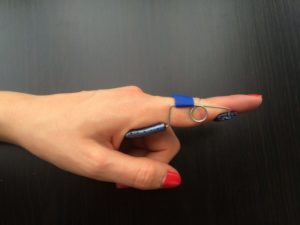
Diagnostic, treatment and possible complications
Stenosing tenosynovitis, commonly known as “trigger finger” or “trigger thumb”, involves the pulleys and tendons in the hand that bend the fingers.
The tendons work like long ropes connecting the muscles of the forearm with the bones of the fingers and thumb. In the finger, the pulleys are a series of rings that form a tunnel through which the tendons must glide, much like the guides on a fishing rod through which the line (or tendon) must pass. These pulleys hold the tendons close against the bone. The tendons and the tunnel have a slick lining that allows easy gliding of the tendon through the pulleys.

Trigger finger/thumb occurs when the pulley at the base of the finger becomes too thick and constricting around the tendon, making it hard for the tendon to move freely through the pulley. Sometimes the tendon develops a nodule (knot) or swelling of its lining.
Because of the increased resistance to the gliding of the tendon through the pulley, one may feel pain, popping, or a catching feeling in the finger or thumb. The catching or triggering action is distinctive. When the tendon catches, it produces inflammation and more swelling. This causes a vicious cycle of triggering, inflammation, and swelling. Sometimes the finger becomes stuck or locked and is hard to straighten or bend.
What causes trigger finger?
Causes for this condition are not always clear. Some trigger fingers are associated with medical conditions such as rheumatoid arthritis, gout, and diabetes. Local trauma to the palm/base of the finger may be a factor on occasion, but in most cases, there is not a clear cause.
Signs and symptoms
Trigger finger/thumb may start with discomfort felt at the base of the finger or thumb, where they join the palm. This area is often tender to local pressure. A nodule may sometimes be found in this area. When the finger begins to trigger or lock, the patient may think the problem is at the middle knuckle of the finger or the tip knuckle of the thumb, since the tendon that is sticking is the one that moves these joints.
Treatment
Medical treatment
The goal of treatment in trigger finger/thumb is to eliminate the catching or locking and allow full movement of the finger or thumb without discomfort. Swelling around the flexor tendon and tendon sheath must be reduced to allow smooth gliding of the tendon. Wearing of a splint or taking an oral anti-inflammatory medication may sometimes help. Treatment may also include changing activities to reduce swelling. An injection of steroid into the area around the tendon and pulley is often effective in relieving the trigger finger/thumb.

Surgical treatment
If non-surgical forms of treatment do not relieve the symptoms, surgery may be recommended. This surgery is performed as an outpatient, usually with simple local anaesthesia. The goal of surgery is to open the pulley at the base of the finger so that the tendon can glide more freely. Active motion of the finger generally begins immediately after surgery.
Normal use of the hand can usually be resumed once comfort permits. Some patients may feel tenderness, discomfort, and swelling about the area of their surgery longer than others. Occasionally, hand therapy is required after surgery to regain better use.

Complications
No surgical intervention guarantees that there will not be secondary complications. Every decision which involves intervention should be aware of the risks that the surgeon has to inform you about.
Common complications related to hand surgery
- Nosocomial infections: they are rare and easily controlled with early diagnosis. Antibiotics and a new intervention may be necessary.
- Hematoma: the diagnosis must be early and surgical revision may also be necessary
- Sudeck syndrome (algodystrophy): this is a “disruptive” pain when there is no underlying problem. Its manifestation is independent of the type of surgery and can occur even after a simple immobilization. The hand becomes swollen, painful, and gradually stiffens. The evolution can be very long. Sequelae are possible (residual pain, the stiffness of the fingers and/or wrist, sometimes of the shoulder). Treatment is difficult and uses specific rehabilitation techniques
- Anaesthesia accident: the easiest but the most serious, including death (1 death per 100,000 to 150,000 anaesthesia).
Complications specific to the trigger finger
-
- Stiffness of the finger: seen especially in old forms. Rehabilitation and equipment are necessary.
-
- Extension of the phenomenon to other fingers: the conflict of the flexor tendon with its sheath occurs more frequently.
-
- Recurrence (rare): it is treated by infiltration and, very rarely, by a reintervention.
-
- Persistent pains: sometimes stubborn, they meet when there is significant synovitis. Rest and prolonged anti-inflammatory treatment may be helpful.
-
- oedema of the base of the finger: frequent and most often transient
- A carpal tunnel syndrome may occur, which in fact indicates the extension of tendon synovitis to the carpal tunnel.
© 2006 American Society for Surgery of the Hand
 Français
Français English
English